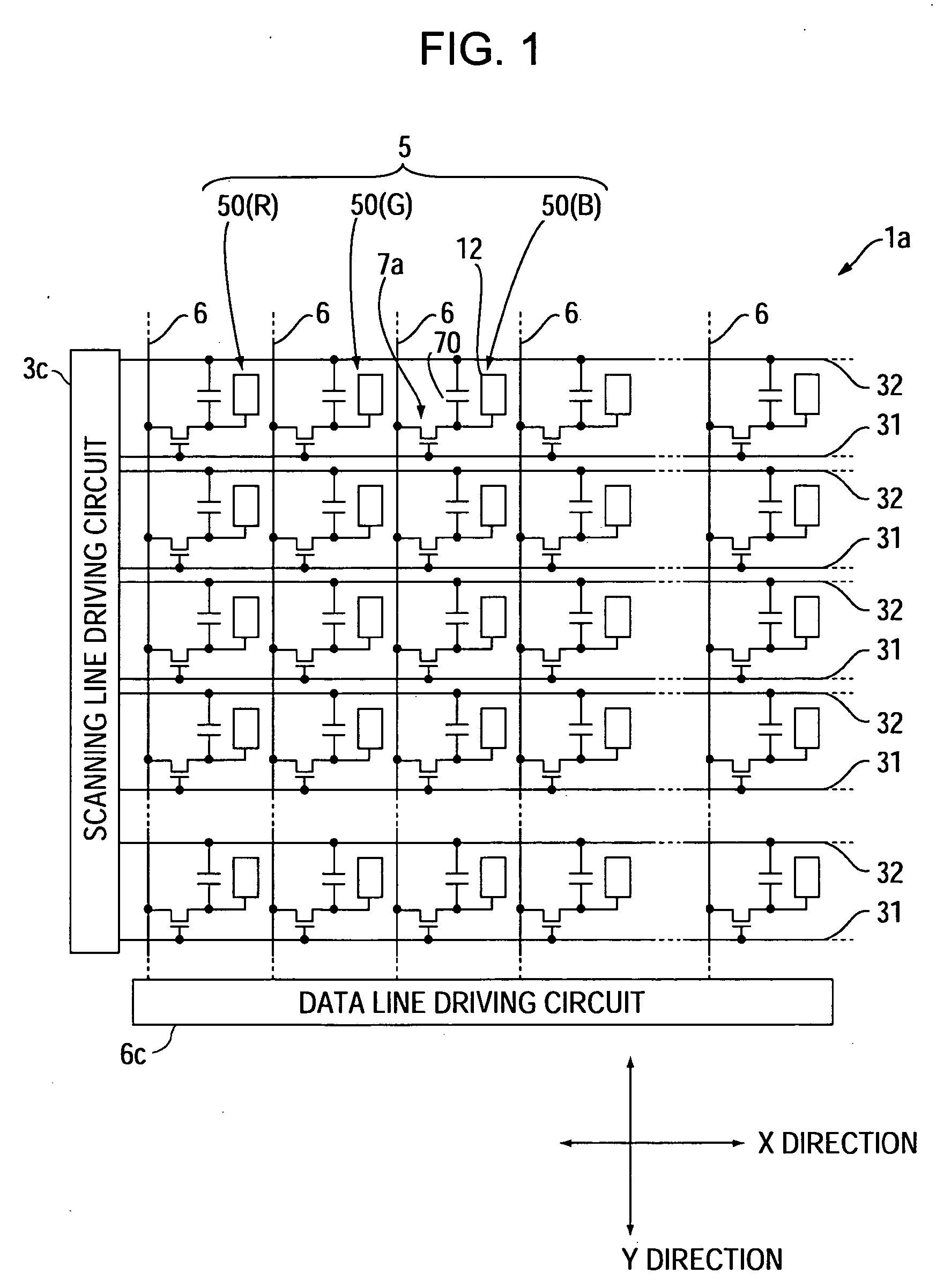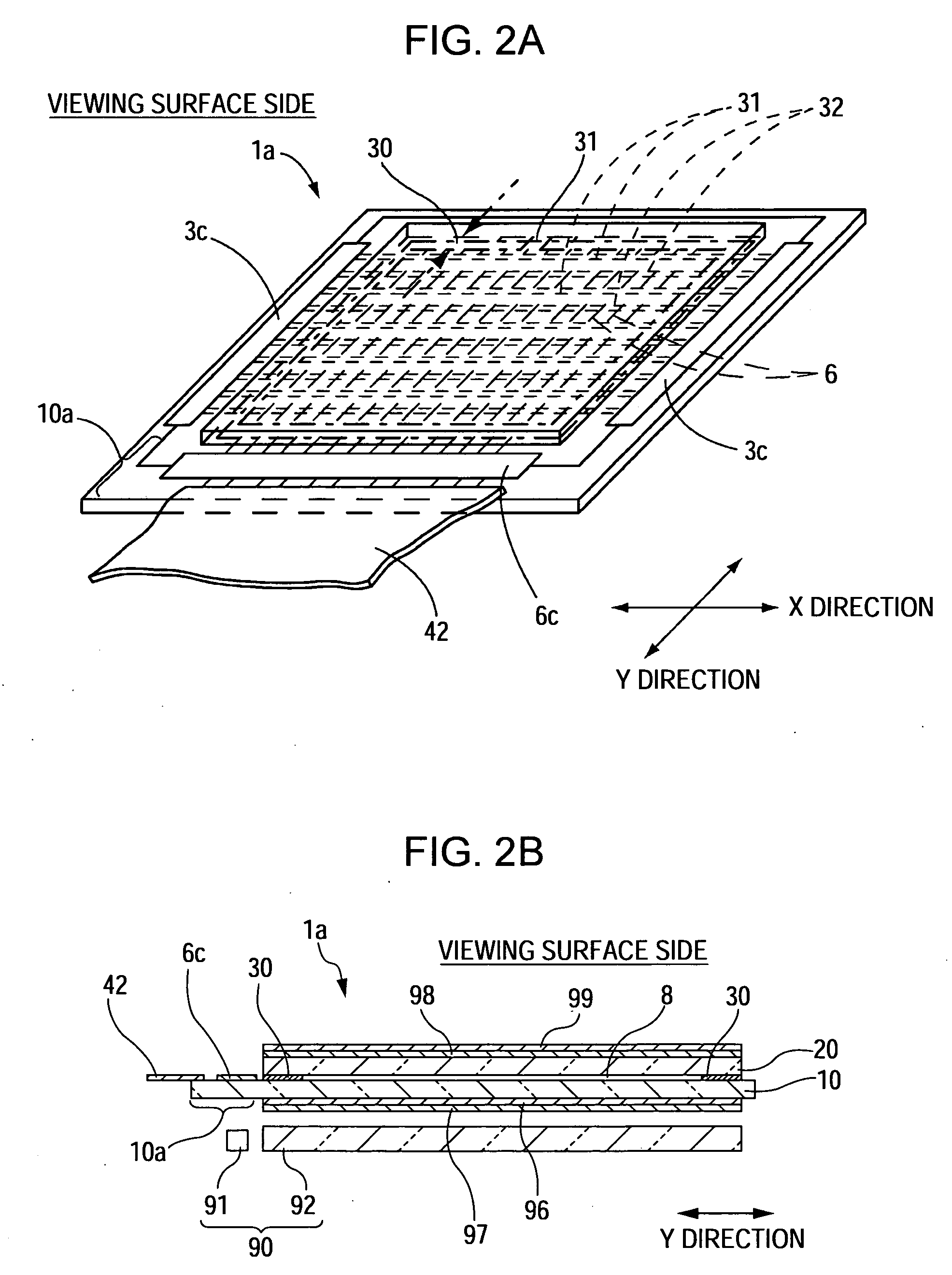Liquid crystal device and electronic apparatus
a liquid crystal device and electronic equipment technology, applied in the field of liquid crystal devices and electronic equipment, can solve the problems of weakening the regulation force of the alignment control unit at the center area of the pixel electrode, notably lowering the pixel aspect ratio, and effectively disposing of slits
- Summary
- Abstract
- Description
- Claims
- Application Information
AI Technical Summary
Benefits of technology
Problems solved by technology
Method used
Image
Examples
first embodiment
General Structure
[0043]FIG. 1 is a block diagram illustrating an electrical structure of a liquid crystal device according to a first embodiment of the invention. FIG. 2A is a schematic perspective view of the liquid crystal device according to the first embodiment of the invention viewed from an oblique upside (counter substrate), and FIG. 2B is a diagram schematically illustrating a cross section of the liquid crystal device according to the first embodiment of the invention cut in a Y direction. It is noted that since the liquid crystal device according to the present embodiment is one for color display and thus pixels correspond to a red light component (R), a green light component (G), and a blue light component (B), reference numerals (R), (G), and (B) are affixed to the pixels corresponding to the respective colors.
[0044] The liquid crystal device 1a shown in FIG. 1 is a transmissive active-matrix-type liquid crystal device using thin film transistors (hereinafter, referre...
second embodiment
[0058]FIG. 5 is a plan view schematically illustrating a structure of a pixel corresponding to a single dot of a liquid crystal device according to a second embodiment of the invention. FIG. 6 is an enlarged cross-sectional view illustrating one of a plurality of pixels formed in the liquid crystal device according to the second embodiment of the invention, and corresponds to a cross-sectional view taken along the line VI-VI of FIG. 5. FIGS. 7A and 7B are diagrams illustrating equipotential lines when slits are formed in a sub-pixel electrode in the liquid crystal device according to the second embodiment of the invention. In addition, since a basic structure of the liquid crystal device according to the second embodiment is the same as that of the first embodiment, and the same constituent elements are denoted by the same reference numerals, and the description thereof will be omitted.
[0059] As in the first embodiment, the liquid crystal device 1a shown in FIGS. 5 and 6 is a trans...
third embodiment
[0072]FIG. 8 is a plan view schematically illustrating a structure of a pixel corresponding to a single dot of a liquid crystal device according to a third embodiment of the invention. FIG. 9 is an enlarged cross-sectional view illustrating one of a plurality of pixels formed in the liquid crystal device according to the third embodiment of the invention, and corresponds to a cross-sectional view taken along the line IX-IX of FIG. 8. Since a basic structure of the liquid crystal device according to the present embodiment is the same as that of the first embodiment, the same constituent elements are denoted by the same reference numerals, and the description thereof will be omitted.
[0073] Differently from the first embodiment, the liquid crystal device 1a shown in FIGS. 8 and 9 is a transflective active-matrix-type liquid crystal device. A reflective layer 16 made of aluminum alloy, silver alloy, or the like is formed on the inner surface of the element substrate 10 in a region, whi...
PUM
| Property | Measurement | Unit |
|---|---|---|
| width | aaaaa | aaaaa |
| height | aaaaa | aaaaa |
| length | aaaaa | aaaaa |
Abstract
Description
Claims
Application Information
 Login to View More
Login to View More - R&D
- Intellectual Property
- Life Sciences
- Materials
- Tech Scout
- Unparalleled Data Quality
- Higher Quality Content
- 60% Fewer Hallucinations
Browse by: Latest US Patents, China's latest patents, Technical Efficacy Thesaurus, Application Domain, Technology Topic, Popular Technical Reports.
© 2025 PatSnap. All rights reserved.Legal|Privacy policy|Modern Slavery Act Transparency Statement|Sitemap|About US| Contact US: help@patsnap.com



